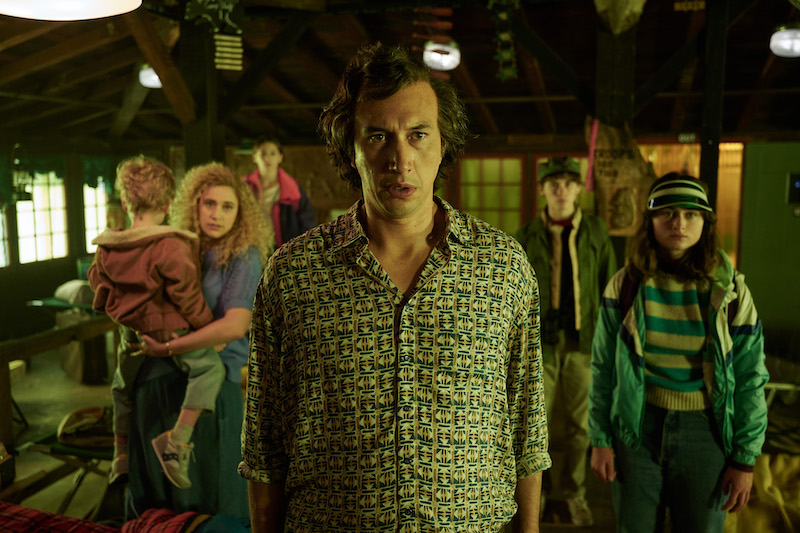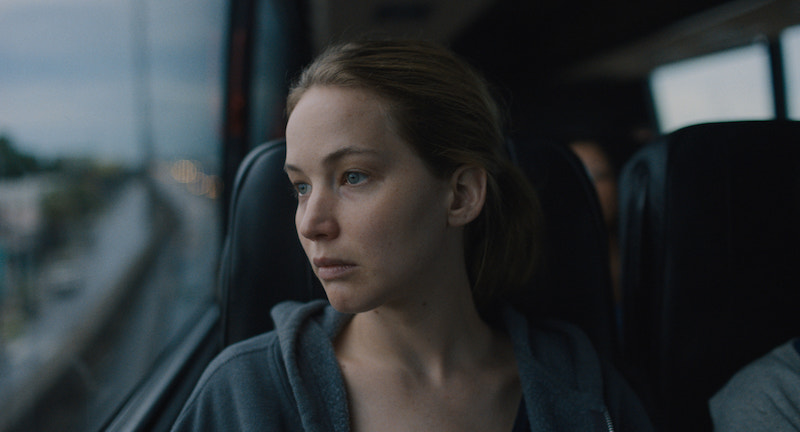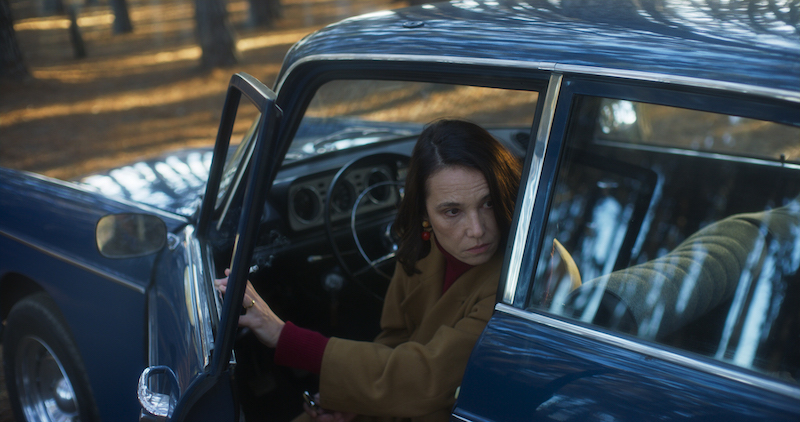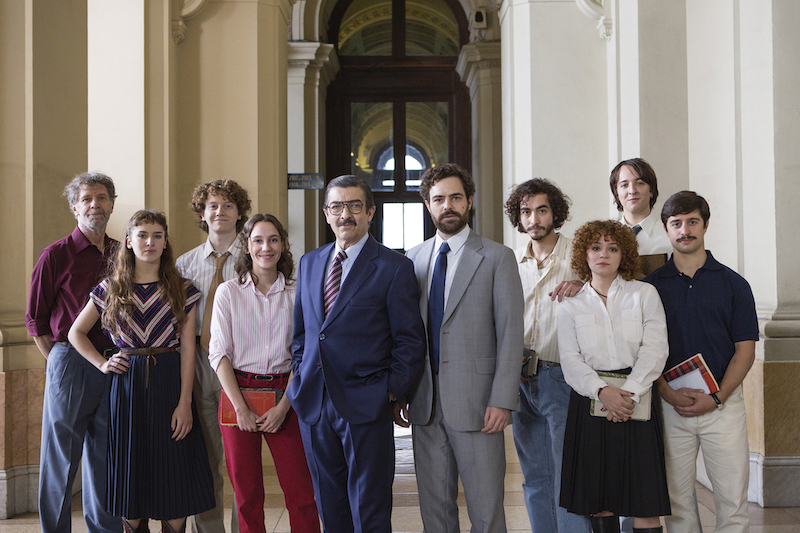London Film Festival 2022 - supermodels, juntas and toxic dust clouds | reviews, news & interviews
London Film Festival 2022 - supermodels, juntas and toxic dust clouds
London Film Festival 2022 - supermodels, juntas and toxic dust clouds
A reminder of just how much we need the collective filmgoing experience

There were decidedly mixed, north-south emotions on the film festival circuit last week: just as the latest edition of the BFI London Film Festival opened, administrators announced the immediate closure of its illustrious UK cousin, the Edinburgh International Film Festival, along with two of Scotland’s most beloved cinemas.
So just as one capital prepared to celebrate cinema – and cinemagoing – another was struggling to come to terms with a kick in the teeth to its cultural heritage, caused by the deadly combination of rising costs and declining, cash-strapped audiences.
The shockwaves from Scotland will be felt for some time yet. In the meantime, Londoners (and those others in the UK that LFF increasingly reaches out to) should be grateful for what they have, and a festival that feels leaner but much stronger after its own pandemic ducking and diving. Artistic director Tricia Tuttle had her own announcement last week, to step down after five-years at the helm, but she’s leaving very much on a high.
While one of Tuttle’s initiatives has been to showcase immersive art and XR works in her Expanded section, one filmmaker who draws you into his work – and feel the pain of his characters – with traditional tech is Ruben Östlund. Earning him his second Palme d’Or in Cannes this year, Triangle of Sadness is another of the Swede’s fascinating, dazzling, superbly executed social satires, of the kind that make audiences cringe in embarrassed recognition.
 Just as The Square homed in on the art world to make devastating points about masculinity, cultural pretention and social division, the new film settles on fashion to explore similar themes and a new one – beauty as currency. The main characters are Carl and Yaya, both models, she an Alpha, he hanging on by his pecs and insanely jealous of his partner, not least the gulf in their earning power – modelling being one of the few occupations where women earn more than men.
Just as The Square homed in on the art world to make devastating points about masculinity, cultural pretention and social division, the new film settles on fashion to explore similar themes and a new one – beauty as currency. The main characters are Carl and Yaya, both models, she an Alpha, he hanging on by his pecs and insanely jealous of his partner, not least the gulf in their earning power – modelling being one of the few occupations where women earn more than men.
Östlund follows the couple from domestic squabbles to a freebie on a luxury cruise ship captained by Woody Harrelson’s cheerily conceived alcoholic Communist (pictured above) and whose passengers constitute a grotesque gallery of uber rich, and finally to a desert island, where social positions are subverted and sex is exchanged for, of all things, Pretzels.
This doesn’t feel as fully accomplished as The Square, or Force Majeure before it, with the island section dissipating much of the enjoyable sense of outrage that’s been building hitherto. But Ostlund’s brilliantly arch sense of humour, bold willingness to extend the embarrassment or excruciation level of a scene to breaking point, and talent for memorable, emotionally immersive set pieces are certainly on display. When the yacht hits a storm during the seven-course Captain’s Dinner, the pyrotechnical, chundering chaos that ensues is truly spectacular.  Another film driven by a crazy energy is White Noise, Noah Baumbach’s adaptation of one of those apparently ‘unfilmable’ novels, in this case by Don De Lillo, which seems to have survived the transition pretty well. It’s a joy in fact, a surreal, very funny, rather prescient account of family, academia, death and supermarkets.
Another film driven by a crazy energy is White Noise, Noah Baumbach’s adaptation of one of those apparently ‘unfilmable’ novels, in this case by Don De Lillo, which seems to have survived the transition pretty well. It’s a joy in fact, a surreal, very funny, rather prescient account of family, academia, death and supermarkets.
It’s set in the Eighties and the fictional College on the Hill, where Professor Jack Gibney (Adam Driver) is basking in the acclaim for his Hitler Studies class, but troubled by an obsession with death that he shares with his wife Babette (Greta Gerwig, above left, with Driver) and which will be lent substance by a “toxic event” that is being blown in the town’s direction.
A long preamble allows for plenty of fun on campus, particularly as it involves fellow teacher Murray (Don Cheadle), who declares that “Elvis is my Hitler” and enlists Jack’s help in making him the Presley powerhouse in the department. But there are darker currents also, notably Babette’s secret pill consumption, and the intimations of serious depression; but before Jack can confronts that, there is a toxic cloud to flee from, allowing for an extended sequence that sees Baumbach – whose work is usually focussed on dialogue – displaying an almost Spielbergian visual flair. Parts of this movie really do feel borne of acid.  At a completely different temperature, Living features one of Bill Nighy’s most affecting performances, as a civil servant in the 1950s coming to terms with his imminent demise. Williams is something of a ghost (or as co-worker Margaret calls him, a zombie), presiding over the public works department of the London County Council with a somnambulant lack of vigour. But the man has a history, a reason for being like this, and the news of his illness sparks a quite beautiful attempt to rediscover some joy in life.
At a completely different temperature, Living features one of Bill Nighy’s most affecting performances, as a civil servant in the 1950s coming to terms with his imminent demise. Williams is something of a ghost (or as co-worker Margaret calls him, a zombie), presiding over the public works department of the London County Council with a somnambulant lack of vigour. But the man has a history, a reason for being like this, and the news of his illness sparks a quite beautiful attempt to rediscover some joy in life.
Based on Akira Kurosawa’s Ikuri, scripted by Kazuo Ishiguro (whose Remains of the Day features a character of equally painful restraint) and directed by Oliver Hermanus, this is a modest, but very moving film. And Nighy, who’s always been fond of his tics and mannerist flourishes, does a lovely job of dialling everything down to a near whisper, playing on our heartstrings from another, more ethereal plane.
Florence Pugh is increasingly reminding me of Kate Winslet: not in the sense of acting style, but in the fact that she can do no wrong, giving one pitch perfect performance after another, which is much rarer than one might think. In Pugh’s case, there’s a clear-eyed, usually still authenticity that verges on the remarkable.
 But no, strictly speaking Pugh is not The Wonder of Sebastian Lelio’s period drama. That would be 11-year-old Anna, a child in an Irish village in 1862, who claims to have survived for four months in perfect good health without any food other than “manna from heaven.” English nurse Lib Wright (Pugh, pictured, with Kila Lord Cassidy) is enlisted by a committee of villagers – divided between churchman and lay, each set on their own truth – to observe the girl for two weeks and deduce whether she is a miracle or a fraudster.
But no, strictly speaking Pugh is not The Wonder of Sebastian Lelio’s period drama. That would be 11-year-old Anna, a child in an Irish village in 1862, who claims to have survived for four months in perfect good health without any food other than “manna from heaven.” English nurse Lib Wright (Pugh, pictured, with Kila Lord Cassidy) is enlisted by a committee of villagers – divided between churchman and lay, each set on their own truth – to observe the girl for two weeks and deduce whether she is a miracle or a fraudster.
Adapted from the novel by Emma Donoghue, this is an intense, niggling mystery, fuelled by the perennial dual between religion and science, as well as the shadow of the Great Famine; as one character puts it, who really cares about “the starvation of one more Irish child”. Caught in the middle of it all is the nurse, fresh from the Crimean war and with her own, deeply personal issues to contend with.
Lelio skilfully balances his characters and options until the very end, infusing the story with a great deal more drama than the premise suggests; Tom Burke and Toby Jones stand out amongst a solid cast; but, not unlike the recent, very different Don’t Worry Darling, Pugh is the bedrock.
 Another fine young actress, Jennifer Lawrence, returns to her roots with Causeway, a low-key, character-driven film dealing with grief, trauma and dysfunctional family – staples of the type of US indie drama, of which Winter’s Boneintroduced Lawrence to the world in 2010.
Another fine young actress, Jennifer Lawrence, returns to her roots with Causeway, a low-key, character-driven film dealing with grief, trauma and dysfunctional family – staples of the type of US indie drama, of which Winter’s Boneintroduced Lawrence to the world in 2010.
She plays Lynsey, a US soldier recovering from a brain injury after being blown up in Afghanistan, who reluctantly returns to her home in New Orleans to complete her rehabilitation. Lynsey’s intolerance of her mother has a hefty amount of guilt to it, which director Lila Neugebauer and her writers subtly take their time in illuminating; in the meantime, Lynsey befriends James (Brian Tyree Henry) a local mechanic with his own demons.
In keeping with a film that eschews the touristy New Orleans for a street level, local’s point of view, the plotting is close to non-existent, the film’s momentum and interest all deriving from the actors; Lawrence and Henry deliver in spades, keeping us engrossed with the simple, growing friendship between damaged souls.  A pair of fine films from South America, while very different, have two things in common – dictatorship, and very significant dates in their titles.
A pair of fine films from South America, while very different, have two things in common – dictatorship, and very significant dates in their titles.
From Chile, Manuela Martelli’s 1976 is the kind of elliptical political drama in which Latin cinema excels, containing its threat in the corners or recesses of the action, slowly building an atmosphere of tension and fear. It’s about two years after the military coup led by General Pinochet. Middle-class Carmen (Aline Küppenheim, above) is renovating her family’s summer beach house when a local priest asks for a favour; but he isn’t honest with her, and slowly Carmen realises that her kind-hearted gesture may have made her a target of the state. As a young actress in 2004, Martelli appeared in the landmark Chilean film Machuca, which focussed on the early days of the coup; with her first film as a director, she’s returned to the subject with thrilling style and intelligence.
Argentina 1985 is an account of the real-life trial of the leaders of the military junta, who presided over a reign of terror between 1976-83 that included abductions, torture and disappearances. The trial was no easy feat for prosecutor Julio Cesar Strassera (Ricardo Darín) and his team, who faced bureaucratic obstruction, death threats and, perhaps worse of all, the hopes of a nation desperate for justice.
Writer-director Santiago Mitre’s masterstroke is to bring humour into the mix of such a serious subject, especially in the Strassera family home, where we could be watching a family sitcom rather than a real-life political drama. But it works, handsomely, reminding us of the ordinary humanity that was so cruelly and routinely quashed by the junta.
Having the great Darín at your disposal doesn’t hurt. When he delivered Strassera’s closing speech, the applause in the Prince Charles Cinema was a moving reminder of the Argentine presence in the audience, for whom Argentina 1985 is much more than a movie, as well as the value of the festivals and cinemas that allow us to share such experiences.
Explore topics
Share this article
The future of Arts Journalism
You can stop theartsdesk.com closing!
We urgently need financing to survive. Our fundraising drive has thus far raised £49,000 but we need to reach £100,000 or we will be forced to close. Please contribute here: https://gofund.me/c3f6033d
And if you can forward this information to anyone who might assist, we’d be grateful.

Subscribe to theartsdesk.com
Thank you for continuing to read our work on theartsdesk.com. For unlimited access to every article in its entirety, including our archive of more than 15,000 pieces, we're asking for £5 per month or £40 per year. We feel it's a very good deal, and hope you do too.
To take a subscription now simply click here.
And if you're looking for that extra gift for a friend or family member, why not treat them to a theartsdesk.com gift subscription?
more Film
 Blu-ray: The Graduate
Post #MeToo, can Mike Nichols' second feature still lay claim to Classic Film status?
Blu-ray: The Graduate
Post #MeToo, can Mike Nichols' second feature still lay claim to Classic Film status?
 Little Trouble Girls review - masterful debut breathes new life into a girl's sexual awakening
Urska Dukic's study of a confused Catholic teenager is exquisitely realised
Little Trouble Girls review - masterful debut breathes new life into a girl's sexual awakening
Urska Dukic's study of a confused Catholic teenager is exquisitely realised
 Young Mothers review - the Dardennes explore teenage motherhood in compelling drama
Life after birth: five young mothers in Liège struggle to provide for their babies
Young Mothers review - the Dardennes explore teenage motherhood in compelling drama
Life after birth: five young mothers in Liège struggle to provide for their babies
 Blu-ray: Finis Terrae
Bleak but compelling semi-documentary, filmed on location in Brittany
Blu-ray: Finis Terrae
Bleak but compelling semi-documentary, filmed on location in Brittany
 Oslo Stories Trilogy: Sex review - sexual identity slips, hurts and heals
A quietly visionary series concludes with two chimney sweeps' awkward sexual liberation
Oslo Stories Trilogy: Sex review - sexual identity slips, hurts and heals
A quietly visionary series concludes with two chimney sweeps' awkward sexual liberation
 Sorry, Baby review - the healing power of friendship in the aftermath of sexual assault
Eva Victor writes, directs and stars in their endearing debut feature
Sorry, Baby review - the healing power of friendship in the aftermath of sexual assault
Eva Victor writes, directs and stars in their endearing debut feature
 Blu-ray: Who Wants to Kill Jessie?
Fast-paced and visually inventive Czech comedy
Blu-ray: Who Wants to Kill Jessie?
Fast-paced and visually inventive Czech comedy
 Oslo Stories Trilogy: Love review - freed love
Gay cruising offers straight female lessons in a heady ode to urban connection
Oslo Stories Trilogy: Love review - freed love
Gay cruising offers straight female lessons in a heady ode to urban connection
 Beating Hearts review - kiss kiss, slam slam
Romance and clobberings in a so-so French melodrama
Beating Hearts review - kiss kiss, slam slam
Romance and clobberings in a so-so French melodrama
 Materialists review - a misfiring romcom or an undercooked satire?
Writer-director Celine Song's latest can't decide what kind of film it is
Materialists review - a misfiring romcom or an undercooked satire?
Writer-director Celine Song's latest can't decide what kind of film it is
 theartsdesk Q&A: actor Leonie Benesch on playing an overburdened nurse in the Swiss drama 'Late Shift'
The Guildhall-trained German star talks about the enormous pressures placed on nurses and her admiration for British films and TV
theartsdesk Q&A: actor Leonie Benesch on playing an overburdened nurse in the Swiss drama 'Late Shift'
The Guildhall-trained German star talks about the enormous pressures placed on nurses and her admiration for British films and TV

Add comment